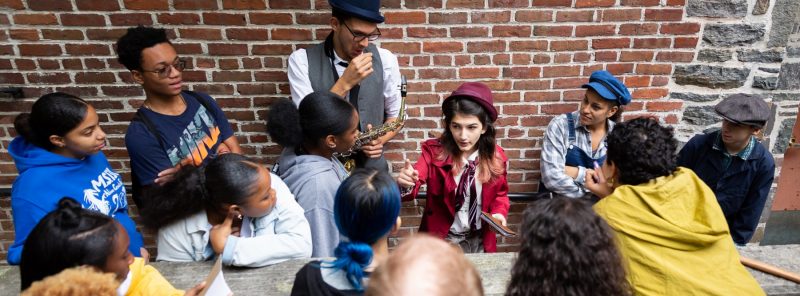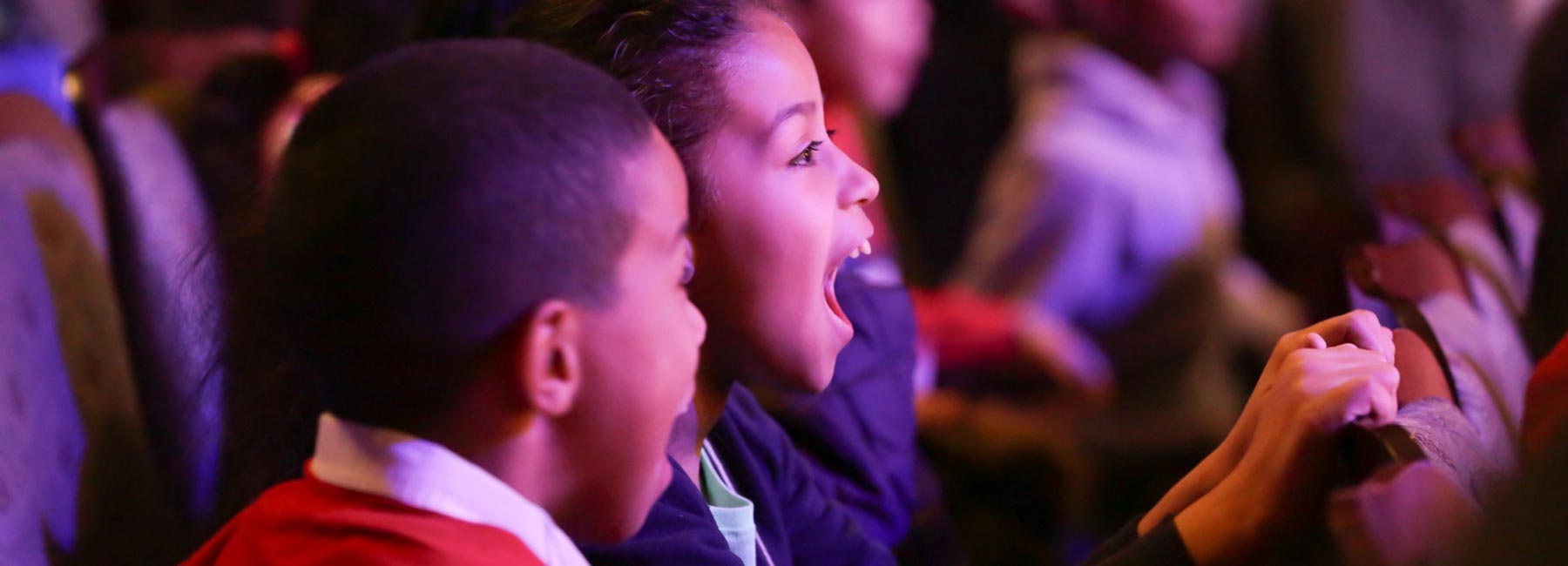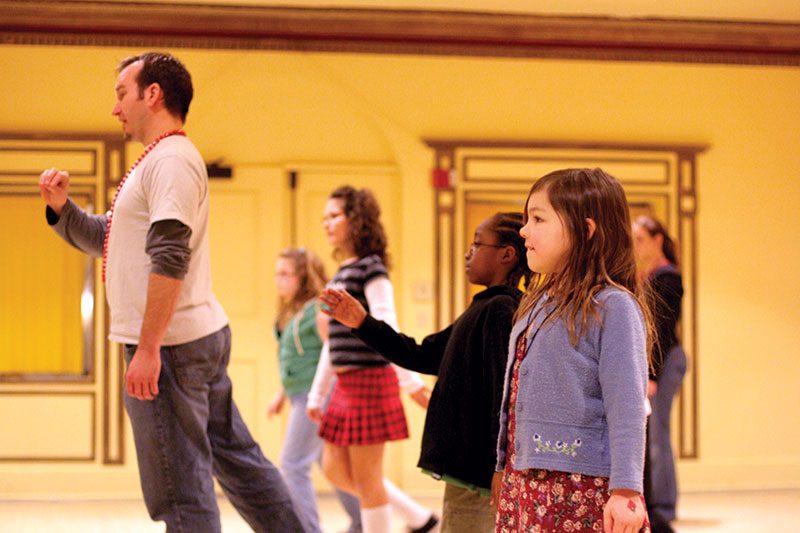The creation of true, authentic, and inclusive circles takes time, intention and considered effort. As members of the Theatre For Young Audiences Community, we must purposely draw the circle wide to incorporate identity groups excluded in the past.
People with disabilities have historically experienced challenges being welcomed and/or sustaining seats within these circles. A BIG step forward was taken recently with Aly Stroker’s Tony win as Best Supporting Actress in a Musical for the 2019 revival of Oklahoma! In our own TYA backyard, member companies work to ensure audiences with disabilities are included with the implementation of sensory friendly and relaxed performances. Many provide ASL interpreting and captioning services. These are important parts of inclusion and should not be discounted. However, next steps are needed to broaden the circle to include individuals with disabilities as actors, directors, playwrights, as well as managing and artistic directors.
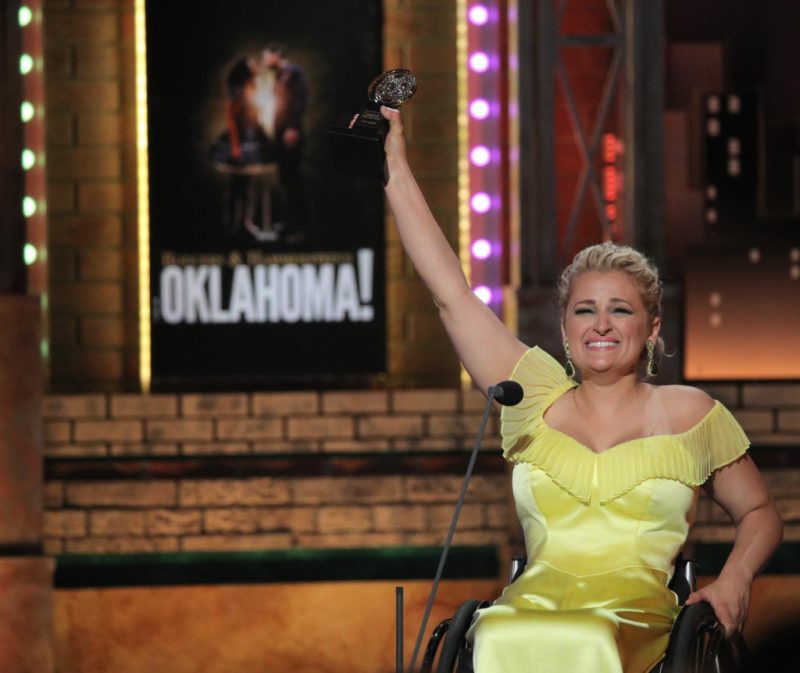
Ali Stroker accepts the Featured Actress in a Musical award for "Rodgers and Hammerstein's Oklahoma!" Photo by Brendan McDermid/Reuters
As with any new initiative, small steps are a good start in ensuring a lasting impact. One path is to harness existing programming already in place. Since 1994, The Rose Theater in Omaha has curated a Teen Theater Season, (called Teens ‘N’ Theater) producing theater important to teen artists. Teens do all the acting, under the guidance of trained theater directors and educators. Teens N Theater was not specifically created as disability specific. However, throughout the program’s twenty-five years of existence many specific instances have occurred in which individuals with developmental and physical disabilities have successfully participated, and thrived, within Teens ‘N’ Theater. The program itself was already structured to be inherently accessible with built-in ensemble check-ins that allow the professionals guiding the room to understand how everyone is taking in and evolving within the process. It is during these check-ins that a director might learn that the student on the autism spectrum feels he or she needs some extra time with a devised scene, while the individual with a physical disability needs some extra time to complete a quick change. At the same time the individuals without documented disabilities have the ability to share their thoughts as well. By creating a big tent of participation, the Rose is ensuring every student artist has a voice.
The Teens ‘N’ Theater program is often used as an entry point for teen artists to participate in other areas of the organization. At the Rose, students who are seniors in high school can participate in an internship program where they learn and participate in as assistant teachers in creative drama classes, work as assistant directors on productions, and explore technical theater. Some of the participating interns have disabilities (both physical and developmental). By the time individuals with disabilities applied for the internships, they are familiar with the institution and they knew how to ask for accommodations. One student with a disability felt she would be successful with a job coach, so time was set aside to work with one. By the time the internship was completed the intern could work independently.
From time to time, the high school internship has been a springboard to the mainstage. One of the high school interns with a physical disability graduated from the program and continues to be cast in main stage productions.
“I think making a choice like this during a casting process can help reframe the concept of disability...Doing this with a role that does not explicitly call for an actor with a disability also helps us deconstruct how ableism functions- after all, why would portrayals of individuals with disabilities be limited only to plays about characters with disabilities?”
— Matt Gutschick, Artistic Director at The Rose Theater
Rose Theater Artistic Director, Matt Gutschick sees value in this. “I think making a choice like this during a casting process can help reframe the concept of disability. Our theater has engaged in this practice from time to time and it can provide audiences with powerful examples of how individuals with disabilities contribute to and often lead our community. Doing this with a role that does not explicitly call for an actor with a disability also helps us deconstruct how ableism functions- after all, why would portrayals of individuals with disabilities be limited only to plays about characters with disabilities?”
The Rose benefits from a history of working directly with those with disabilities, capitalizing on how each individual works and learns best. This results in a deeper understanding of how to authentically widen the institutional circle. The familiarity allows both parties to be comfortable openly discussing any adjustments needed to ensure success.
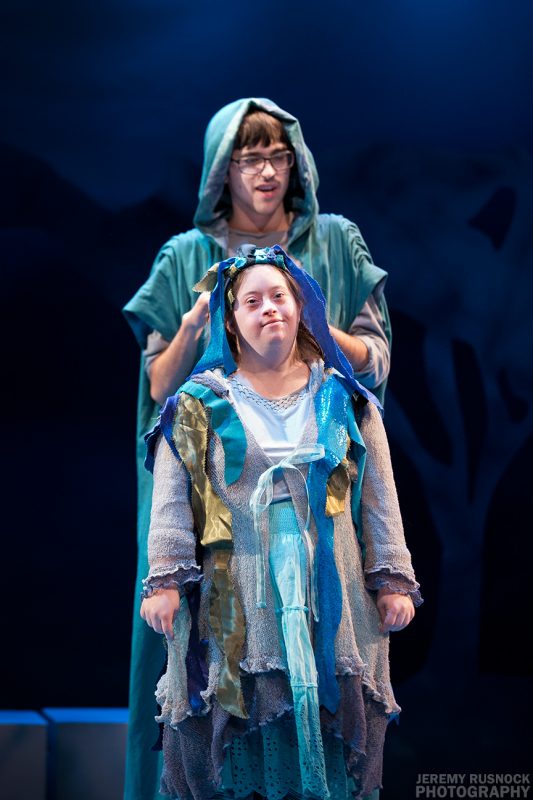
O, Wonder! A Tempest Tale (based on Shakespeare's The Tempest). These photos were taken by Jeremy Rusnock Photography, LLC
Another possible strategy to widen the circle is to intentionally create programs that focus only on individuals with disabilities. Kate Bryer, Associate Artistic Director at Imagination Stage (Bethesda, Maryland), says that the theatre initially had conservatory acting companies for individuals without disabilities as distinct from opportunities for individuals with disabilities without formal training. Eventually the education staff decided to mirror what they were doing with the conservatories and offer a conservatory focused solely on teens with disabilities. This resulted in these teens being professionally trained for two years, just like the other conservatories. At the conclusion of the professional training program, the artists with disabilities performed in a show directed and designed by adult professionals. According to Bryer, this program gives artists with and without disabilities high quality training. “You would never hire an actor without a disability without training, why should hiring an actor with a disability be any different?” says Bryer.
“An actor with a disability is just like any other actor. All actors deserve and should have professional training, particularly in a conservatory setting that results on a high caliber production, designed and directed by professional artists—all of our kids deserve this training opportunity.”
— Kate Bryer, Associate Artistic Director at Imagination Stage
The alumni of Imagination Stage Conservatory Program have acted in other D.C. theaters. This program investment has enabled area institutions to cast disabled actors. Bryer mentioned several instances when actors with disabilities were successfully cast in productions for young audiences. “Kids don’t see disability,” according to Bryer. “An actor with a disability is just like any other actor. All actors deserve and should have professional training, particularly in a conservatory setting that results on a high caliber production, designed and directed by professional artists—all of our kids deserve this training opportunity.” Bryer has found a unique and individual way of collaborating with these artists, just as she would with any new collaborators. This reflects another way to intentionally widen an artistic community’s circle to all future theater participants.
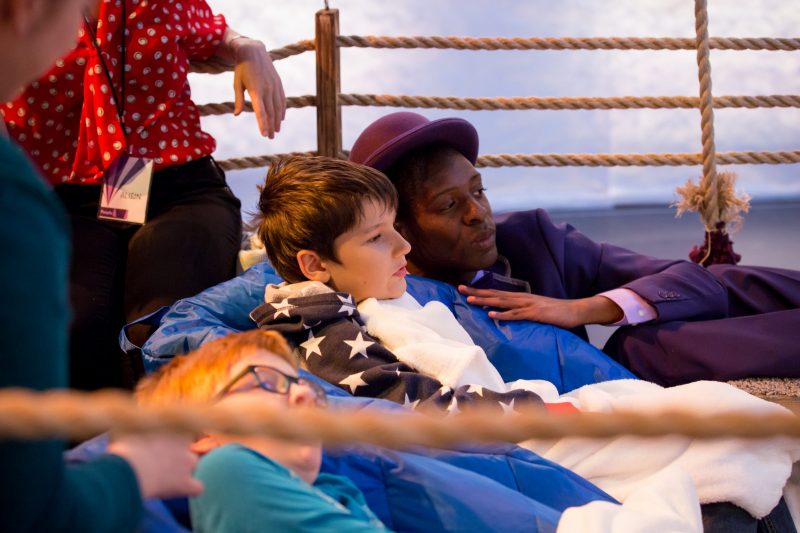
Up and Away, created by Trusty Sidekick Theater Company and Commissioned by Lincoln Center Education. Photo: Hyphen Photography.
What happens when a theatre company desires to create a production especially for individuals with disabilities?
Trusty Sidekick, Bluelaces Theater Company, and Chicago Children’s Theater’s Red Kite are doing just that. Each company has a unique yet similar approach to this work. Trusty Sidekick created Up and Away (commissioned by Lincoln Center), which is specifically for individuals on the autism spectrum. The production featured actors as one-on-one guides taking audience members on a hot air balloon ride. The work was developed over several years in collaboration with schools that serve young people on the autism spectrum. Trusty Sidekick interacted with one hundred and twenty students during the development process, guiding a series of residencies in which students on the autism spectrum contributed through active participation in creative drama and story play. Up And Away premiered at Lincoln Center in 2015, and returned for Lincoln Center’s Big Umbrella Festival (a month-long celebration of programming for audiences on the autism spectrum) in 2018. The production was unique because it limited its audience size to 8 children with their families so that participants had an individualized experience and were not overwhelmed. Each audience member sat in a balloon with an actor as a tour guide through the whole experience. The result was a multi sensory experience that did not over stimulate the participants. Drew Petersen, Artistic Director of Trusty Sidekick has reflected on the impact of the piece, “To me, one of the largest impacts Up and Away has had on its audiences is not only the show’s longevity but also the amount of other works and worlds that have been created for this unique population. A few years ago, in New York and in the United States, plays created specifically for neuro-diverse young people were hard to come by. Now, it seems there is a new offering for this audience every week and not just in the theater art form but in other artistic disciplines like music, visual art, and dance. How exciting for Trusty Sidekick and Up and Away to be just one of a wonderful range of artistic offerings for this population.” Since the creation of Up And Away, Trusty Sidekick continues to develop new work with individuals with disabilities as participants in the process and performers in the piece itself.
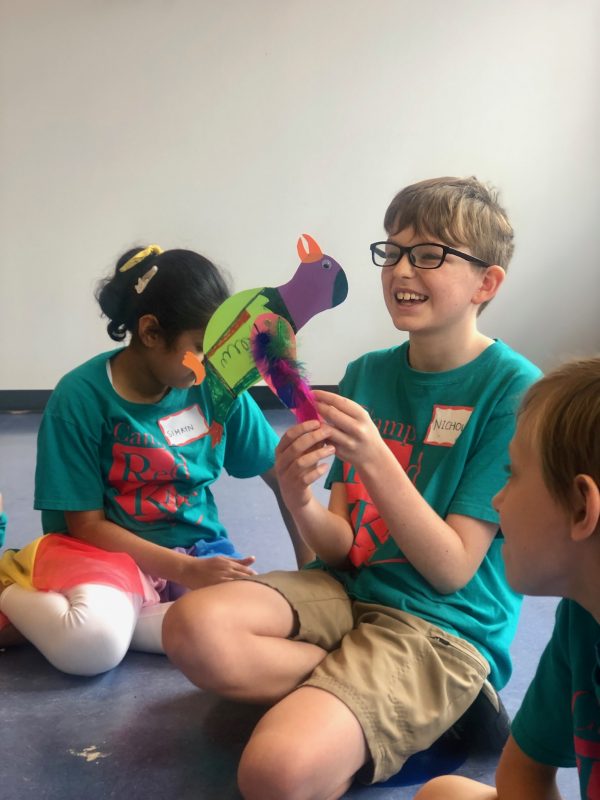
Red Kite camp program at Chicago Children's Theatre. Photo Credit: Jane Kittendorf.
Red Kite is a flagship program of Chicago Children’s Theatre. The Red Kite Project was the inspiration of Artistic Director Jacqueline Russell. After a decade of teaching drama to kids with autism, Russell wanted to expand and deepen the project. Around this time, she had the opportunity to study with Oily Cart in London, a company that pioneered a tradition of creating theatre for young people with disabilities (it is worth noting that Trusty Sidekick studied with Oily Cart as well). After returning from London, Russell created a buffet table of offerings for children on the autism spectrum including classroom residencies, camps, and classes. Chicago Children’s Theatre also creates original productions that are specifically tailored to children on the autism spectrum and their families. In the same spirit, Bluelaces Theater Company designs productions with individuals with autism and other developmental disabilities in mind, inspired by the notion that every person experiences art in their own way. Each participant experiences the show with an Adventure Guide who helps participants experience the play in their own way. These are just a few examples of specialized work being created for this audience around the world.
What if a theatre wants to create a traditional scripted production that calls for an individual with a disability playing an individual with a disability? What are some specific strategies for casting individuals with disabilities in productions? What has to be done to ensure authentic representation and a quality production?
Children’s Theater of Madison started early to cast the role of Caitlin when it produced Julie Jensen’s play, Mockingbird (opening in February 2020) . According to Access for All Coordinator, Megwyn Sanders-Andrews, “Children’s Theatre of Madison works to cast inclusively for all our productions. However, this is the first time we’ve actively recruited an actor with autism for a lead role. During these auditions, we wanted the audition space to be as free from distractions as possible. We also stated in the audition notice accommodations, such as a preview of space and materials, fidgets, sensory boxes and noise-cancelling headphones would be available for the auditions. We are very fortunate to have strong partnerships in the community with organizations serving youth with autism: Achieving Collaborative Treatment and CI Pediatric Therapies. It partners with us every step of the way,” stated Sanders-Andrews.
What about artists with disabilities creating new work to add to the TYA cannon? Co-founded by Mickey Rowe and Talleri McRae, the newly formed National Disability Theatre is adding dynamic and interesting work to the field and collaborating with highly respected institutions like La Jolla Playhouse. “NDT’s first project will be a brand new play for young audiences. NDT is collaborating with La Jolla Playhouse for their 2020 Performance Outreach Program (POP) Tour for young audiences, to be written by National Disability Theatre’s Advisory Company Member and Lucille Lortel Award winner, Gregg Mozgala (Cost of Living) and A.A. Brenner,” according to Talleri McRae, Founding Co-Executive Director of National Disability Theatre. “This brand new piece of TYA (currently in development) will have a young disabled protagonist who will explore the history of disability rights as she learns more about herself and her community,” McRae shared. “It’s a wonderful opportunity to start a direct conversation with young people about disability and difference, and at the same time, by simply including artists with disabilities in any performance (whether or not the story of the play is about disability) is a powerful statement about the value of diversity in society.”
How can a company diversify and widen its applicant pool to include people with disabilities?
According to Betty Siegel, Director of VSA and Accessibility at The John F. Kennedy Center for the Performing Arts, the way to begin is to specifically state you are open to hiring individuals with disabilities in your job descriptions. Plan and be open to whoever walks in the door. Don’t worry about making tweaks or accommodations to facilities or job duties until the time comes. According to Seigel, it is not “if a person with a disability can do a job, but when they get the job what he or she is going to accomplish!”
“Representation matters. What we see on television, in film and on stage communicates our values. By including artists (actors, directors, designers and artisans) with disabilities in our work, we are communicating disability is valuable.”
— Talleri McRae, Founding Co-Executive Director of National Disability Theatre
Why should we do all of this work to include individuals with disabilities within our artistic circle? Does it really help our audience?
According to Talleri McRae, “Representation matters. What we see on television, in film and on stage communicates our values. By including artists (actors, directors, designers and artisans) with disabilities in our work, we are communicating disability is valuable. It is not a deficit; it is a culture, with its own humor, history and traditions. People with disabilities have a lot to say.Historically, a catch phrase among disability activists has been, ‘Nothing about us without us.’ I like its most recent update, ‘Nothing without us.’ How exciting to think about a future where the disability community is simply included among non-disabled peers.”
Quoting award winning playwright, Kevin Kling, “Disability may make you different, but what makes you different gives you power.” That power will enable TYA institutions to widen our circles to ensure, collectively, we are stronger than ever.

